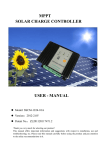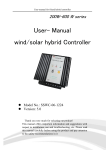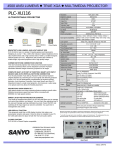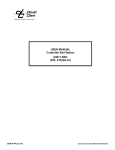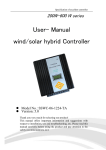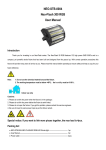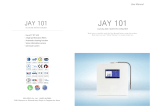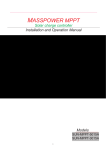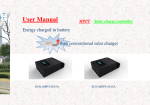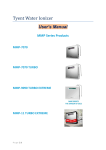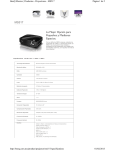Download 12V/24V 10A MPPT Solar Controller User Manual
Transcript
MPPT SOLAR CHARGE CONTROLLER USER - MANUAL Model: SSCM-1224-5A/10A/15A/20A Version:3.0 Thank you very much for selecting our product! This manual offers important information and suggestions with respect to installation, use and troubleshooting, etc. Please read this manual carefully before using the product and pay attention to the safety recommendations in it. Contents 1. 2. 3. 4. 5. 6. Important Safety Operation Information…………………………..2 General Safety Information……………….…….………………..2 General Description…………………………………………….….2 Product features……………………..…………………………...3 Instruction for panel of controller………….………………………3 Installation Instructions ………………………………………4 6.1 General Installation Notes ……………………………………4 6.2 Mounting ………………………….……………………………4 6.3 System connection with controller……………………………5 Step 1: Battery Wiring….………………………….…....………5 Step 2: Loading Wiring….…………………………….…...……6 Step 3: Solar Module Wiring……………………….…….……7 Step 4: Switch power wiring….………..…….…………..……7 7. 8. 9. 10. 11. 12. 13. 14. Step 5: Confirmation for Wiring ………………..……………..8 Step 6: Power-up sequence ……………………………………8 Instructions For LED indications ………………………………….9 Load work mode ……..……………………………………………10 Load work mode setting ……………………………………………10 Protections, Troubleshooting and Maintenance ……………………11 Warranty …………………….……………………………………..12 MPPT Technology Introduction………………….…..……………12 Outline dimensions………………………….……………..………14 Controller technical data …………………………………………15 Page 1 1. Important Safety Operation Information This manual contains important safety, installation and operating instructions for controller. WARNING: Reverse connection of positive (+) and negative (-) is prohibited ! Short-circuit of positive (+) and negative (-) is prohibited ! CAUTION: If your battery voltage lower than 9V, connect to controller is prohibited! Controller was damaged much possibly caused by this occurrence. Solar panel and loading rated power do not higher than controller rating accordingly. 2. General Safety Information Please don’t use low quality battery to avoid leakage, rust or burn. Please don’t use thin or low quality cable to avoid leakage or fire. Do not open cover and maintain personally. Keep it away from water, moist, rain, severe dust, shaking, corrosion and Intensive or under intense electromagnetic interference. This machine prohibited around the place with any flammable, explosive and dangerous goods. Keep any symbols on the controller complete. To avoid accidents, keep it away from this children. 3. General Description The friendly wind/solar hybrid controller is specially designed for high-end small-scale wind/solar hybrid system and especially suitable for wind/solar hybrid street light system and wind/solar hybrid monitoring system. Topology Diagram Page 2 4. Controller Features Our MPPT controller which represents advanced technology. The features are listed below: 12V/24V auto recognition. Advanced maximum power point tracking technology to optimize using the solar system. Peak conversion efficiency of 95%, high Tracking efficiency of 97%. Very fast sweeping of the entire I-V curve several seconds tracking speed. Widely used, automatic recognize day/night. Timer function with 1-17 hours option for street light system. Unique dual timer function, enhance the flexibility of street light system. Sealed, Gel and Flooded battery be suitable. Adopting temperature compensation and correcting the charging and discharging parameters automatically, improving the battery lifetime. Electronic protection: over charging, over discharging ,overload short circuit. Reverse protection: any combination of solar module and battery, without causing damage to any component. Excellent thermal design and nature air cooling. 5. Instruction for panel of controller ① -- Charging Status LED Indicator ② -- Battery Status LED Indicator ③ -- Output DC power Status LED Indicator ④ -- Temperature Sensor ⑤ -- Setting Button for load work mode ⑥ -- LED Digital Display for the load work mode ⑦ -- Switch power supply connection terminals ⑧ -- Loading terminals for connection of load Page 3 ⑨ -⑩ -6. Battery Terminals for Connection of batteries. Solar Module Terminals for Connection of solar modules. Installation Instructions 6.1 General Installation Notes Read through the entire installation section first before beginning installation. Be very careful when working with batteries. Wear eye protection. Have fresh water available to wash and clean any contact with battery acid. Uses insulated tools and avoid placing metal objects near the batteries. Explosive battery gasses may be present during charging .Be certain there is sufficient ventilation to release the gasses. Avoid direct sunlight and do not install in locations where water can enter the controller. Loose power connections and /or corroded wires may result in resistive connections that melt wire insulation, burn surrounding materials, or even cause fire. Ensure tight connections and use cable clamps to secure cables and prevent them from swaying in mobile applications. Use with Gel, Sealed or Flooded batteries only. Battery connection may be wired to one battery or a bank of batteries. The following instructions refer to a singular battery, but it is implied that the battery connection can be made to either one battery or a group of batteries in a battery bank. Select the system cables according to 3A/mm² current density. 6.2 Mounting NOTE: When mounting the controller, ensure free air through the controller heat sink fins. There should be at least 150mm of clearance above and below the controller to allow for cooling. If mounted in an enclosure, ventilation is highly recommended. WARNING: Risk of explosion! Never install the controller in a sealed enclose with flooded batteries! Do not install in a confined area where battery gas can accumulate. Step 1: Choose Mounting Location: Locate the controller on a vertical surface protected from direct sun, high temperature, and water. Step 2: Check for Clearance: Place the controller in the location where it will be mounted. Verify that there is sufficient room to run wires and that there Page 4 is sufficient room above and below the controller for air flow Step 3: Mark Holes: Use a pencil or pen to mark the four (4) mounting hole locations on the mounting surface. Step 4: Drill Holes: Remove the controller and drill four sizeable holes in the marked locations. Step 5: Secure Controller Place the controller on the surface and align the mounting holes with the drilled holes in step 4. Secure the controller in place using the mounting screws. 6.3 Wiring NOTE: 1) A recommended connection order has been provided for maximum safety during installation. 2) The controller is a negative ground controller. Any negative connection of solar module, battery or load can be earth grounded as required. Grounding is recommended. CAUTION: 1) Don’t connect the loads with surge power exceeding the ratings of the controller. 2) For mobile applications, be sure to secure all wiring. Use cable clamps to prevent cables from swaying when the vehicle is in motion. Unsecured cables create loose and resistive connections which may lead to excessive heating and/or fire. Step 1: Battery Wiring WARNING: Risk of explosion or fire! Never short circuit battery positive ( + ) and negative (-) or cables Before connecting the battery, measure the battery voltage. It must be over 9V to power the controller. For 24V, the voltage must be greater than 18V to properly detect a 24V battery. The 12/24V battery detection is automatic and the check is only performed at start-up. The controller will identify system by detection of this parameter. If the battery voltage is between 16V-17V, the controller is in discriminant blind spot, the controller will not work normally, please be noted. Wire an in-line fuse holder no more than 150mm from the battery positive terminal. Do not insert a fuse at this time. Confirm the connection correct and then turn on the power. Page 5 Step 2: Load Wiring The controller load output can connect DC electronic devices of which rated voltage is same as battery’s. Device will provide battery voltage to the loads. DC loading could be LED lamp or monitor devices etc. 1. 2. 3. 4. Connect load1 positive ( + ) and negative ( - ) to the controller related terminals and connect load2 positive ( + ) and negative ( - ) to the controller related terminals accordingly. The load terminals may exist voltage, connect carefully to avoid short circuit. An in-line fuse holder should be wired in series in the load positive (+) or negative (-) wire as shown. Do not insert a fuse at this time. Confirm the connection are correct. If wiring the load connection to a load distribution panel, each load circuit should be fused separately. The total load draw current should not exceed the 10A load rating. Page 6 Step 3: Solar Module Wiring WARNING Risk of electric shock! Exercise caution when handling solar wiring. The solar module(s) high voltage output can cause severe shock or injury. Cover the solar module(s) from the sun before installing solar wiring. CAUTION: 1. If you can not confirm the scientific and rational PV module connection by series or parallel way, please contact the manufacturer of controller. 2. The controller can be applied to the single crystal silicon, polycrystalline silicon, thin-film photo voltaic group 3. PV groups open circuit voltage (Voc) do not higher than rated battery bank voltage 1.8times. (suggest be 1.5times ) 4. PV groups operation voltage (Vmp) do not higher than rated battery bank voltage 1.5times. (suggest be 1.2times) Step 4: Switch power supply Wiring If your buy unit isn’t this type mode, please ignore following guide. Please skip to next step 6 Page 7 1. Please make sure connection are correct with switch power related terminals 2. Switch power AC input terminal please connect with your city-electric. Please refer to instruction from manufacturer of switch power. CAUTION: reverse polarity connection was prohibited! Step 5: Confirmation for Wiring Double-check the wiring in step1 through 4.Confirm correct polarity at each connection. Verify that all six power terminals are tightened. Step 6: Power-up sequence after confirmation of connection 1. Turn-on battery 2. Turn-on solar panel 3. Turn-on DC loading 4. Turn-on switch power for city-electric (if be this mode) CAUTION: if you would take down system as need, must comply with following sequence. Remove solar panel ⇒ Remove DC load ⇒Remove batteries 1.When the battery power up, the controller starts, three LED will be blinkingsi multaneously3 times. The controller are in the initialization and detection devi ce status of each system. 2.Delay of about one minute later, the controller output indicator LED to light. At the moment indicates have the DCpower output (when not connected to the solar panels or solar panel voltage below 6V case). Page 8 If the controller does not start properly, or don,t have the output DC power sup ply after the normal start. Please check the following 1).Please confirm if the battery positive and negative have connections correctl y, solidly. 2). Please use a multi-meter to measure if the battery voltage is of 9V or more. 3).After the controller connected to battery, there is 1 minutes delay output DC power supply 4).When the battery is in discharge, the controller will cut off the DC power su pply output 5).Street lighting system, if on day time , no DC power output is a normal phenomenon. 7. Instructions For LED indications Figure:7-1 ① charge LED: When installation completed and sunlight on solar modules color LED status Controller status System status green Lighting ON MPPT charging normal green blinking MPPT tracking normal Lighting OFF Night normal ② Battery LED: color LED System status status Red Lighting ON Battery low volume Red blinking Battery high volume Lighting OFF normal Page 9 ③ DC power output LED: Color LED status System status Re-mark Green Lighting ON normal(night) Street-light Lighting OFF normal(day) system Lighting ON normal(24 constant output) Monitor system Green ⑥ Digital Led It’s meaning DC power output time (hours) 8. Load work mode This device be able to do following 8terms output ways, please requested which type are your expectation before you buy. * NOW, YOUR ARE USING TYPE IS √ ITEM. (A)output 1th line, 2nd line all are constant output DC power for monitor system. (B) 1th line is ON/OFF by lighter, 2nd line is lighter and timer control When solar module voltage goes below the point of NTTV (Night Time Threshold Voltage) at sunset, the solar controller will recognize the starting voltage and turn on the load after 1 minutes delay for several hours which users set on the timer. The timer setting operation is referred to as “Load Work Mode Setting”. 9. Load work mode setting For setting timer value of digitron. Use method as below: setting:press 5secs. The digitron will be blinking,meaning you have already enter in setting condition.。press one time, the value will be plus +1. if right down point is lighting, this value will plus +10. save:stop press key,then 10sec. later, the digitron will stop blinking to be lighting, ,this meaning saving successfully. Then the digitron will be turn off about 15sec. later. Digitron will be lighting once connection completed. And turn off Page 10 ** after 20sec. if you want to look value of setting, please short press the key. Setting value range: 0-17(hours). IF YOU BUY CONSTANT OUTPUT FOR YOUR MONITOR SYSTEM, PLEASE IGNORE ABOVE TIMEER SETTING. AND ALLSO CONTROLLER HAVE ABATE THIS FUNCTION. Remind! When you have completed setting, please to disconnection battery aim to turn off controller, then after 10seconds, re-start connection of battery to turn on controller. This process is intent to make sure the program running in modified setting condition. 10. Protections, Troubleshooting and Maintenance 10.1 Protection PV Array Short Circuit If PV array short circuit occurs, clear it to resume normal operation. PV Overvoltage If PV Overvoltage occurs, the array will remain disconnected until the voltage falls safely below the maximum rating. Load Overload If the load current exceeds the maximum load current rating, the controller will disconnect the load. Overloading must be cleared up through reapply power . Load Short Circuit Fully protected against load wiring short-circuit. After one automatic load reconnect attempt, the fault must be cleared by reply power or pressing the setting button. PV Reverse Polarity Fully protection against PV reverse polarity, no damage to the controller will result. Correct the mis-wire to resume normal operation. Battery Reverse Polarity Fully protection against battery reverse polarity, no damage to the controller will result. Correct the mis-wire to resume normal operation. High Voltage Transients PV is protected against high voltage transients. In lightning prone areas, Page 11 additional external suppression is recommended. 11. Warranty The charge controller is warranted to be free from defects for a period of TWO (2) years from the date of shipment to the original end user. We will, at its option, repair or replace any such defective products. Claim procedure: Before requesting warranty service, check the Operation Manual to be certain that there is a problem with the controller. Return the defective product to us with shipping charges prepaid if problem cannot be solved. Provide proof of date and place of purchase. To obtain rapid service under this warranty, the returned products must include the model, serial number and detailed reason for the failure, the module type and size, type of batteries and system loads. This information is critical to a rapid disposition of your warranty claim. This warranty does not apply under the following conditions: 1. Damage by accident, negligence ,abuse or improper use. 2. PV or load current exceeding the rating of product. 3. Unauthorized product modification attempted repair. 4. Damage occurring during shipment. 5. Damage results from acts of nature such as lightning, weather extremes. 6. Irreclaimable mechanical damage. 12. MPPT Technology Introduction 1) The Tracer utilizes Maximum Power Point Tracking technology to extract maximum power from the solar module(s). The tracking algorithm is fully automatic and does not require user adjustment, Tracer technology will track the array maximum power point voltage (Vmp) as it varies with weather conditions, ensuring that maximum power is harvested from the array through the course of the day. 2) This controller takes buck MPPT charging way, it can improve the solar panels’ power output capability and the energy efficiency. The whole dynamic tracking, no manual Settings, speed, high accuracy. The followings are PV solar graph & Power voltage graph Page 12 Take the 24V system for example. Configure a solar panel as follow: Rated power P=300W Rated power voltage Vmpp=36V Rated powe current Impp=8.33A Open-circuit voltage Voc=44V Short-circuit current Isc=9A P (power) =V (voltage)* I (current) In the rated luminous intensity and temperature, the PV modules can output 300w power. When the charging way is normal, the PV modules voltage is near to the battery’s voltage, the actual output current increase is less. The voltage drop and the controller work in a normal way as the PV solar graph shows. The voltage range of battery is 21V~28.8V. If the controller’s conversion efficiency is 100% and ignore the controller voltage drop, we can know through the curve that when battery voltage is 21V, the actual PV modules output power P=21V* 8.5A =178.5W (power point 3), and know the charging current to battery is 8.5A; but when battery voltage is 28.8V, the actual PV modules output power P=28.8V* 8.4A =242W (power point 1) ,and know the charging current to battery is 8.4A; Power 178.5W 194.4W 211.3W 226.8W 242W Voltage 21V 23V 25V 27V 28.8V Current 8.5A 8.45A 8.45A 8.4A 8.4A From this, it can be seen that PV modules output power increased with the increase of battery voltage, and the average power to battery is 210W (power point 2); in fact the controller’s conversion efficiency won’t be 100%, so the actual average power to battery will less than 210w. The other more than 90W power couldn’t be extracted , caused a waste of energy. This MPPT solar controller works near the maximum power point. Through Page 13 collecting the date of pv output voltage and current , the maximum power point is determined. That makes PV modules worked at voltage 34V ~38V (this voltage change is dynamic change), the corresponding current is 8.34 A ~7.5 A. Power 283.6W 291.6W 300W 296W 285W Voltage 34V 35V 36V 37V 38V Current 8.34A 8.33A 8.33A 8. 0A 7.5A Also, PV modules output power is 285W~300W, the average power is 292.5W (the unextracted average power 7.5W is dynamic loss). If the controller’s conversion efficiency is 92%, battery can get 268.6W power actually. At this time if battery voltage is 21V, the charging current will be 12.8A; if battery voltage is 28.8V, the charging current is 9.33A . This two currents are both larger than PV output current, so the Energy utilization rate of MPPT way improves more than 27.9% than ordinary way. The above contents are examples for understanding MPPT solar charging, and may have a little difference form practical application. There is a relationship between the ascension of energy’s utilization rate and the difference between solar panels’ Vmpp and battery voltage. The biger the difference between Vmpp and battery voltage is ,the higher energy’s utilization rate is. 13. Outside dimension Page 14 14. 1. Controller technical data Solar module configuration : system Vmp Min. Vmp standard Vmp Max. 12V 15V 18V 25V 24V 30V 36V 45V Good charging efficiency need higher than Vmp Min 2. Performance Max. VOC of solar panel 65V Max. power from solar panel 240W (12V) ;480W (24V) Controller operation Charge current rated 9V Min.(12V );18V Min(24V) 5A 10A 15A 20A Controller power ≦30mA Charging efficiency 90%-95%, Peak on 97% Current of output Max. Temperature compensation coefficient Ambient temp. range 10A Store temp. range -35℃ to +80℃ Humidity range 10% - 90% Protection class IP52 3. Battery parameters System Over-discharge -35mV/℃ (25℃ ref.) -35℃ to +55℃ 12V 10.5V Over-discharge recovery 12.0V 24V 20V 24V Page 15 (NC) floating 14V Over-ch arge 13.5V Over-charge recovery 15.0V 28.0V 27.0V 30.0V
















